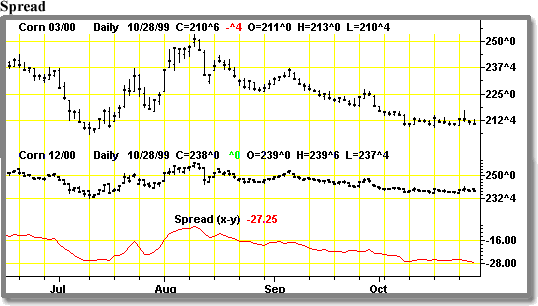BullVersus BearSpread Trading in Grains
Post on: 20 Июль, 2015 No Comment

Bull-Versus Bear-Spread Trading in Grains
Spread trading is a good way to take advantage of your analysis in the grain futures markets and execute a trading strategy without placing yourself at risk of widespread, unexpected market movements. For instance, if you have a spread trade wherein you are long 2 new crop corn futures contracts and short 1 new crop soybean futures contract, even if the whole grain sector rockets up in response to a weaker dollar, your losses from the short soybean position should be offset by your gains in the long corn position.
However, the decision to go bullish or bearish on a particular grain futures spread requires careful study and deep understanding of the forces behind supply and demand in that particular grain market. The most common type of spread trade in grain futures is a “calendar” spread, wherein a trader will go long and short in two different contracts with two different expiration dates within one market. For instance: long September oats and short December oats, or short May soybeans and long March soybeans. This is different than intermarket spread trading, like the example above where the spread trader is long and short in two different markets (corn and soybeans). But because the calendar spreads rarely move too far outside of their usual ranges, it typically has smaller profit objectives per trade and it requires a heavy volume of trading to make it worthwhile.
The two types of a calendar spread trade are a bull spread trade (wherein the trader expects the price difference between the two contracts to grow wider over time) or a bear spread trade (wherein the trader expects the price different between the two contracts to grow narrower over time). Be cautious when using those definitions, because “wider” and “narrower” only refer to typical, positive spreads which are generally seen in the grain markets when deferred contract prices are higher than nearby contract prices (e.g. May corn is usually priced higher than March corn). If, however, the market becomes “inverted” (March corn worth more than May corn), the calendar spread is negative. Then a bull spread trade is one where you expect the spread to grow less negative and perhaps back into positive territory, and a bear spread trade is one where you expect the spread to grow more negative (more inverted).
How you decide whether to execute a bull or bear calendar spread in the grain markets depends on your analysis of the market’s supply and demand. Grains are produced annually and usually have a positive spread structure to encourage owners to store the grain off the market throughout the year. If a farmer will receive 30 cents per bushel more for delivering his grain three months from now than what the market is offering today, he will choose to store the grain. A bear spread trade may be chosen if one sees particularly strong demand or weak supply for a given period of time in a grain market. If the market needs a grain urgently, it will pay relatively more in the nearby (usually lower-priced) contract month. Urgent demand for a short supply of grain, therefore, can make calendar spreads grow narrower or even grow inverted. A bull spread trade benefits when the market pays more in deferred months to keep the grain off the market. There are storage and interest costs to consider, however, and generally the market spreads don’t offer more than the full cost of storage and interest, so a bull spread trade will typically have a limit to its profit potential.














